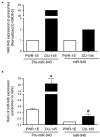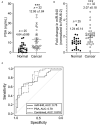MicroRNA-940 as a Potential Serum Biomarker for Prostate Cancer
- PMID: 33816263
- PMCID: PMC8017318
- DOI: 10.3389/fonc.2021.628094
MicroRNA-940 as a Potential Serum Biomarker for Prostate Cancer
Abstract
Prostate cancer is one of the leading causes of death despite an astoundingly high survival rate for localized tumors. Though prostate specific antigen (PSA) test, performed in conjunction with digital rectal examinations, is reasonably accurate, there are major caveats requiring a thorough assessment of risks and benefits prior to conducting the test. MicroRNAs, a class of small non-coding RNAs, are stable molecules that can be detected in circulation by non-invasive methods and have gained importance in cancer prognosis and diagnosis in the recent years. Here, we investigate circulating miR-940, a miRNA known to play a role in prostate cancer progression, in both cell culture supernatants as well as patient serum and urine samples to determine the utility of miR-940 as a new molecular marker for prostate cancer detection. We found that miR-940 was significantly higher in serum from cancer patients, specifically those with clinically significant tumors (GS ≥ 7). Analysis of receiver operating characteristic curve demonstrated that miR-940 in combination with PSA had a higher area under curve value (AUC: 0.818) than the miR-940 alone (AUC: 0.75) for the diagnosis of prostate cancer. This study provides promising results suggesting the use of miR-940 for prostate cancer diagnosis.
Keywords: PSA; circulating miRNA; miR-940; prostate cancer; serum.
Copyright © 2021 Rajendiran, Maji, Haddad, Lotan, Nandy, Vishwanatha and Chaudhary.
Conflict of interest statement
The authors declare that the research was conducted in the absence of any commercial or financial relationships that could be construed as a potential conflict of interest.
Figures




Similar articles
-
Profiling of Circulating microRNAs in Prostate Cancer Reveals Diagnostic Biomarker Potential.Diagnostics (Basel). 2020 Mar 28;10(4):188. doi: 10.3390/diagnostics10040188. Diagnostics (Basel). 2020. PMID: 32231021 Free PMC article.
-
Diagnostic performance of expression of PCA3, Hepsin and miR biomarkers inejaculate in combination with serum PSA for the detection of prostate cancer.Prostate. 2015 Apr 1;75(5):539-49. doi: 10.1002/pros.22942. Epub 2015 Jan 18. Prostate. 2015. PMID: 25597828
-
Zinc α2-glycoprotein as a potential novel urine biomarker for the early diagnosis of prostate cancer.BJU Int. 2012 Dec;110(11 Pt B):E688-93. doi: 10.1111/j.1464-410X.2012.11501.x. Epub 2012 Sep 28. BJU Int. 2012. PMID: 23020913
-
miRNAs as novel biomarkers in the management of prostate cancer.Clin Chem Lab Med. 2017 May 1;55(5):715-736. doi: 10.1515/cclm-2015-1073. Clin Chem Lab Med. 2017. PMID: 26751899 Review.
-
The usefulness of microRNA in urine and saliva as a biomarker of gastroenterological cancer.Int J Clin Oncol. 2021 Aug;26(8):1431-1440. doi: 10.1007/s10147-021-01911-1. Epub 2021 Apr 9. Int J Clin Oncol. 2021. PMID: 33835295 Review.
Cited by
-
Editorial: Machine learning-based methods for RNA data analysis-Volume II.Front Genet. 2022 Nov 29;13:1010089. doi: 10.3389/fgene.2022.1010089. eCollection 2022. Front Genet. 2022. PMID: 36523762 Free PMC article. No abstract available.
-
The Potential of MicroRNAs as Non-Invasive Prostate Cancer Biomarkers: A Systematic Literature Review Based on a Machine Learning Approach.Cancers (Basel). 2022 Nov 3;14(21):5418. doi: 10.3390/cancers14215418. Cancers (Basel). 2022. PMID: 36358836 Free PMC article.
-
The influence of selected microRNAs on the expression profile of genes and proteins related to the tumor necrosis factor-alpha signaling pathways in endometrioid endometrial cancer.J Cancer Res Clin Oncol. 2023 Sep;149(12):9679-9689. doi: 10.1007/s00432-023-04863-3. Epub 2023 May 26. J Cancer Res Clin Oncol. 2023. PMID: 37233761 Free PMC article.
-
The Potential Diagnostic and Prognostic Value of Circulating MicroRNAs in the Assessment of Patients With Prostate Cancer: Rational and Progress.Front Oncol. 2022 Feb 4;11:716831. doi: 10.3389/fonc.2021.716831. eCollection 2021. Front Oncol. 2022. PMID: 35186706 Free PMC article. Review.
-
The potential of cell-free and exosomal microRNAs as biomarkers in liquid biopsy in patients with prostate cancer.J Cancer Res Clin Oncol. 2022 Oct;148(10):2893-2910. doi: 10.1007/s00432-022-04213-9. Epub 2022 Aug 4. J Cancer Res Clin Oncol. 2022. PMID: 35922694 Free PMC article. Review.
References
Grants and funding
LinkOut - more resources
Full Text Sources
Other Literature Sources
Research Materials
Miscellaneous

